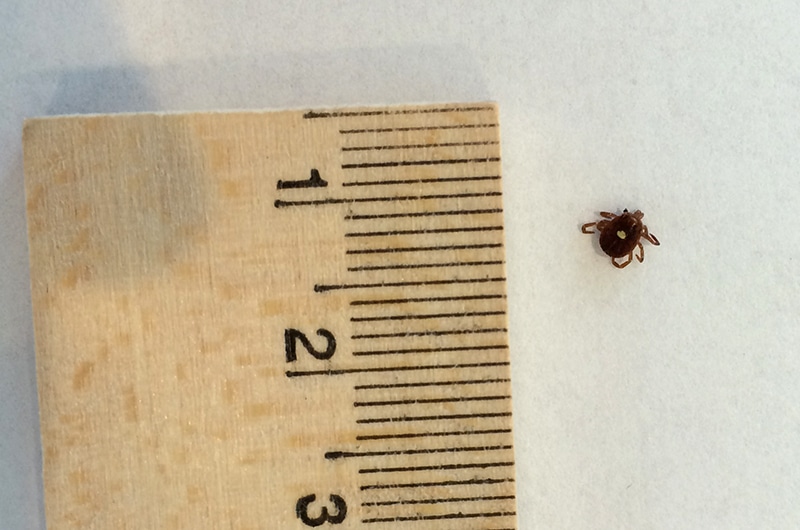by Dr. Sarah T. Bois, Director of Research & Education for the Linda Loring Nature Foundation

Lyme Disease.
Lyme disease is caused by an infection with a spirochete (a type of bacteria) which can be transmitted to people by bites from nymphal and adult deer ticks. Many of the symptoms of early Lyme’s mimic flu-like symptoms. Other tick-borne diseases passed on through ticks include human Babesiosis and Ehrlichiosis. Symptoms are similar for all three infections, but treatments differ. When going to the doctor with a tick bite, they will generally test for all possible tick-borne diseases, but make sure with your doctor.
Powassan Virus.
This tick-borne illness has been in the news a lot this summer despite its rarity. According to the Center for Disease Control (CDC) website, approximately 75 cases of Powassan virus disease were reported in the United States over the past 10 years and there were only 8 reports on Massachusetts up until 2015. Recently, Dr. Catherine Brown, deputy state epidemiologist, confirmed that there have been three deaths in Massachusetts due to the Powassan virus, but was vague on the timing of these deaths. Unlike Lyme and other tick-borne bacterial infections, Powassan is a virus for which there is no treatment except supportive care. This disease remains extremely rare and has never been found on Nantucket. For more information on Powassan check out the CDC website: cdc.gov/powassan/index.html.
Lone Star Ticks.
This tick species is a recent find in our region. Prevalent in the southeastern US, their distribution has been expanding with global climate change. Currently, the only known established population of lone star ticks (LST) in our area is on Sandy Neck Beach on Cape Cod. An established population consists of individuals of all life stages (adults, nymphs, and larvae). There are some suspect sites on Martha’s Vineyard that are being investigated. In 2015, after a weekend trip to Tuckernuck, I had a tick bite from a LST. It was only attached a short time, and I was able to remove it swiftly. I did, however, have the tick tested (tickreport.com). See below for more information about tick testing.
Lone star ticks are known to be more aggressive than the deer and dog ticks. They actively “hunt” down a host instead of passively hoping one walks by. Lone star ticks, fortunately, don’t transmit Lyme’s, but they have their own unique set of diseases. They carry tularemia, human ehrlichiosis, and STARI (southern tick associated rash illness). The most sensational headline that gets repeated, with a hint of truth, is that the LST bite can make you allergic to red meat (anywhere from hives to anaphylactic shock). The good news, however, is that LST’s are less likely to carry pathogens than deer ticks. While there have been individuals found on Tuckernuck, there are no official reports of LST on Nantucket. However, there has been a lot of personal stories of these ticks that I have heard first-hand, so keep your eyes out.
What can you do?

What if I find a tick attached? There are lots of various implements for tick removal and many of them work. I am a fan of needle-nose tweezers which you can get at any drug store. Just be sure to get the head. If you don’t get the head, go to the doctor. If it has been on you longer than 24 hours, go to the doctor. You will likely not see a bullseye, so don’t wait for one to appear. Lyme’s is treatable as are the other tick-borne diseases commonly found on Nantucket, but early detection is the key.
There are also two great resources that can answer all of your tick questions and will even go the extra mile, if you are interested. The Tick Encounter Resource Center (TERC) (tickencounter.org), out of the University of Rhode Island, offers a plethora of regional tick information based in science and with important information from the CDC. Not only is it a great source of information, but you can participate! Have a tick? Take a photo and send it in. The information they gather through volunteer participation allows TERC to create maps of infestations and calculate a Tick Encounter Index.
Still not satisfied?
Do you need to know if that tick was a carrier for any diseases? TERC now partners with the UMass Laboratory of Medical Zoology and their tickreport.com to offer reliable tick testing at low cost and fast turnaround time. Now you can contribute to science and send the tick in for test ing yourself! Not only will you get a report of what pathogens the tick may have been carrying, but you are contributing to important research. Tick Report was borne from the mind of Dr. Steven Rich at UMASS. As a microbiologist studying pathogens and tick-borne diseases, he heard from people who are truly concerned about the “tick epidemic” in their areas. Tapping into the concerned citizens allows Dr. Rich’s lab to collect a multitude of data while providing a service to interested people. Dr. Rich also has a history of Nantucket-based tick research. His lab has been trapping and testing small mammals around the island for ticks and then testing the ticks for various pathogens.
After I found a lone star tick on me in 2015, I called Dr. Rich and sent in my tick. The results came back in a few days and all was well. My tick was negative for every possible disease. Phew.
My final word of advice is to relax. There are lots of hazards in life and things to be wary of. Armed with knowledge, we can make good choices and do our best to avoid dangers such as ticks. But nowhere is perfect and free of all dangers. Remember to have a good time, stop and smell the roses, and see some of our beautiful island, ticks and all.


